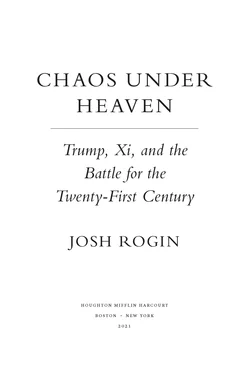“The Greatest Financial Scandal in World History”
The Wall Street argument is that if Chinese companies can’t raise money in the United States, they will just do it somewhere else—and that US financial firms have a fiduciary obligation to get the best return for their investors. But Robinson points out that the US capital markets are still the largest and most respected in the world by far; simply put, there is nowhere else for Chinese corporations to go for money—at least, no other financial wells that have anywhere near the depth, volume, and liquidity of the US markets. China’s domestic currency, the renminbi, isn’t tradeable outside its border. In order for China to expand economically and press its interests by spreading money around the world, it first needs to collect said money from outside China.
What’s more, US financial firms’ fiduciary responsibilities are not the extent of their duty as American corporations. Indeed, Wall Street’s chief obligation, Robinson argues, is to protect American investors from fraud and from becoming complicit in China’s military expansion and internal repression, which can represent asymmetric material risk to these American investors.
Wall Street’s contention, that its investment in Chinese companies is separate from and unrelated to Washington’s drive to compete with China and confront Beijing’s malign behavior, was never true. Nor is it a defensible position, now that Chinese companies have become the most prominent implementers of Beijing’s strategy. How can the Commerce Department sanction Hikvision while US financial firms are sending American dollars to it at the same time? How can Wall Street steer the pensions of American soldiers into Chinese companies that are building the weapons pointed back at them? As the Chinese government has speeded up its fusion of military and civilian activities, it has forced the US system to respond—whether all parts of that system want to or not.
Wall Street’s behavior was not just undermining the short-term US goal of pressuring the Chinese government into a deal that would correct the trade imbalance and secure Beijing’s promise to end its unfair trade practices. Robinson said the larger point is that China is going around the world buying elites, countries, even continents with a seemingly endless supply of money that they are getting from US citizens. Americans are contributing mightily to the funding of the Chinese government’s strategy to surpass the United States. If the United States wants to thwart that plan, it must force Chinese companies to comply with US laws or be denied access to US investors. In doing so, the United States can preserve its primacy, protect its citizens, preserve the integrity of its markets, and thwart Beijing’s malign activities all at once, Robinson said.
“We have used little, if any, of the leverage associated with our utter dominance of the global financial domain,” Robinson said, “even though it involves China’s single greatest weakness and one of America’s greatest strengths—access to money. How have we done nothing about this over the past twenty years? This may well be the greatest financial scandal in world history.”
13
Endgame
As 2019 wound down, Trump’s trade team was still traveling back and forth to Beijing, trying to get a deal in place so that Trump could enter his election year with a foreign policy accomplishment that he could run on. Beijing had called his bluff. They had reneged on their pledges from earlier in the year, and Steven Mnuchin and Robert Lighthizer were still at the table. The time advantage had flipped back to Beijing. The Chinese economy was not breaking. Xi Jinping was president for life. But Trump had an election coming up.
Meanwhile, the effort by several national security agencies across the government to push back on China was humming along as fast as ever, if not faster. The Justice Department was scooping up more and more Chinese spies and prosecuting more and more cases again Chinese businesspeople and researchers thieving inside the United States. The Commerce Department kept sanctioning more companies complicit in the Xinjiang atrocities. The State Department put in new rules for Chinese diplomats, requiring them to report if they were going to meet with federal, state, or local officials of any kind while they were posted inside the United States. This was advertised as an example of “reciprocity,” in response to China’s severe restrictions on American diplomats there. But it was nice for State to know who the Chinese were meeting with, as well.
Vice President Pence gave another big China speech in October, which had previously been delayed because of the trade talks. But while the vice president was talking tough against China, US and Chinese economic officials were meeting to work out a deal. This dissonance did not go unnoticed by the general public. Was this an example of two camps inside the administration pursuing two different China policies? Or was there a logic to it? The argument some officials made at this time was that the US government was learning to walk and chew gum—to pursue some engagement and negotiations with Beijing while getting tough at the same time. But the notion that the Trump administration had a coherent approach to China, or on anything related to foreign policy, was hard to defend when Trump got directly involved. His swings back and forth—sometimes within the same day—ensured that nobody ever really knew what his China policy was at a given moment.
The last few months of the trade talks were full of threats and brinksmanship that ultimately ended in capitulation. In early August, when Mnuchin returned from his latest trip to Beijing, Trump was getting antsy. No longer trusting Mnuchin’s advice, he denied the Treasury secretary’s request to delay the next round of tariffs and announced that the United States would impose 10 percent tariffs on another $300 billion of Chinese imports, including consumer goods like toys, shoes, and clothes. These represented a new class of products coming from China that had been largely left untouched, because tariffs on consumer goods were likely to raise prices for US consumers, also known as voters. But Trump threatened it anyway. “When my people came home, they said we’re talking. We have another meeting in early September,” said Trump. “I said, ‘That’s fine.’ But in the meantime, until such time as there’s a deal, we’ll be taxing them.”
It was a major escalation, and China responded in kind—but with an underhanded reprisal that would allow it to hit back not once, but twice. In the short term, Beijing reacted to the new tariffs by allowing the tightly controlled yuan to slip to an eleven-year low, a move that could only result from a deliberate decision by Beijing. The move made Chinese exports cheaper and US exports more expensive, offsetting the effect of Trump’s tariffs. It also spooked the markets and led to the Dow Jones dropping 3 percent in one day. Late in the day on August 5, Mnuchin’s Treasury Department, under White House orders, formally named China a “currency manipulator,” the designation Mnuchin had talked Trump out of in 2017.
Two weeks later, the administration announced it would split those tariffs into two tranches, delaying tariffs on toys and consumer electronics (about $160 billion worth of imports) until December 15. The idea was to give a break to Americans who were buying and selling holiday presents. It was also an implicit admission that Trump was fibbing when he said the tariffs only cost China and didn’t have costs for the United States.
Trump’s billionaire friends were trying hard to steer him toward making a deal, any deal, and quick. Sheldon Adelson met with Trump at the White House on August 20 and told him in no uncertain terms he was risking not only the health of the US economy but also his reelection prospects with the new tariffs.
Читать дальше











